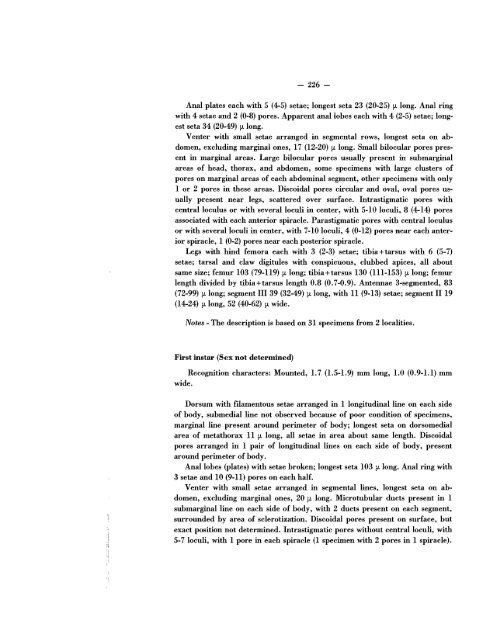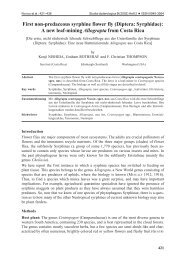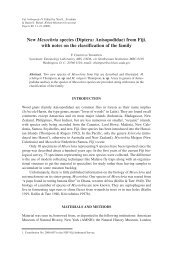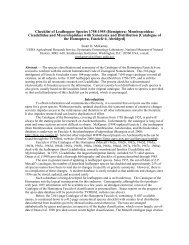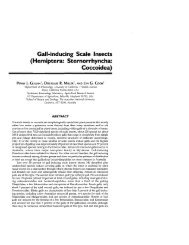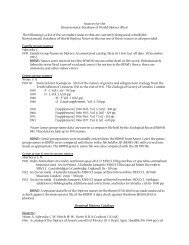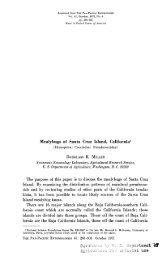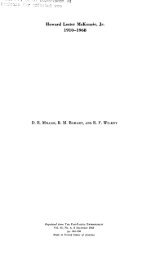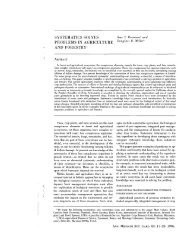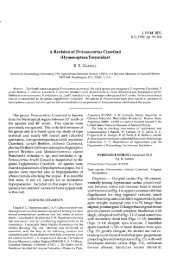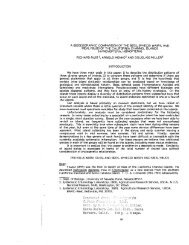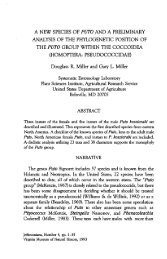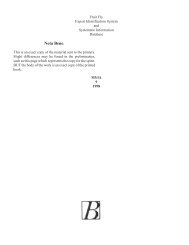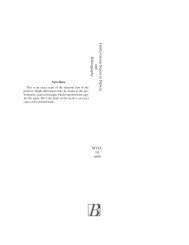Systematic revision of the Family Micrococcidae (Homoptera ...
Systematic revision of the Family Micrococcidae (Homoptera ...
Systematic revision of the Family Micrococcidae (Homoptera ...
You also want an ePaper? Increase the reach of your titles
YUMPU automatically turns print PDFs into web optimized ePapers that Google loves.
- 226<br />
Anal plates each with 5 (4-5) setae; longest seta 23 (20-25) (J. long. Anal ring<br />
with 4 setae and 2 (0-8) pores. Apparent anal lobes each with 4 (2-5) setae; longest<br />
seta 34 (20-49) (J. long.<br />
Venter with small setae arranged in segmental rows, longest seta on abdomen,<br />
excluding marginal ones, 17 (12-20) (J. long. Small bilocular pores present<br />
in marginal areas. Large bilocular pores usually present in submarginal<br />
areas <strong>of</strong> head, thorax, and abdomen, some specimens with large clusters <strong>of</strong><br />
pores on marginal areas <strong>of</strong> each abdominal segment, o<strong>the</strong>r specimens with only<br />
1 or 2 pores in <strong>the</strong>se areas. Discoidal pores circular and oval, oval pores usually<br />
present near legs, scattered over surface. Intrastigmatic pores with<br />
central loculus or with several loculi in center, with 5-10 loculi, 8 (4-14) pores<br />
associated with each anterior spiracle. Parastigmatic pores with central loculus<br />
or with several loculi in center, with 7-10 loculi, 4 (0-12) pores near each anterior<br />
spiracle, 1 (0-2) pores near each posterior spiracle.<br />
Legs with hind femora each with 3 (2-3) setae; tibia +tarsus with 6 (5-7)<br />
setae; tarsal and claw digitules with conspicuous, clubbed apices, all about<br />
same size; femur 103 (79-119) (J. long; tibia+tarsus 130 (111-153) (J. long; femur<br />
length divided by tibia +tarsus length 0.8 (0.7-0.9). Antennae 3-segmented, 83<br />
(72-99) (J. long; segment III 39 (32-49) (J. long, with 11 (9-13) setae; segment II 19<br />
(14-24) (J.long, 52 (40-62) (J. wide.<br />
Notes - The description is based on 31 specimens from 2 localities.<br />
First instar (Sex not determined)<br />
Recognition characters: Mounted, 1.7 (1.5-1.9) mm long, 1.0 (0.9-1.1) mm<br />
wide.<br />
Dorsum with filamentous setae arranged in 1 longitudinal line on each side<br />
<strong>of</strong> body, submedial line not observed because <strong>of</strong> poor condition <strong>of</strong> specimens,<br />
marginal line present around perimeter <strong>of</strong> body; longest seta on dorsomedial<br />
area <strong>of</strong> metathorax 11 (J. long, all setae in area about same length. Discoidal<br />
pores arranged in 1 pair <strong>of</strong> longitudinal lines on each side <strong>of</strong> body, present<br />
around perimeter <strong>of</strong> body.<br />
Anal lobes (plates) with setae broken; longest seta 103 (J. long. Anal ring with<br />
3 setae and 10 (9-11) pores on each half.<br />
Venter with small setae arranged in segmental lines, longest seta on abdomen,<br />
excluding marginal ones, 20 (J. long. Microtubular ducts present in 1<br />
submarginal line on each side <strong>of</strong> body, with 2 ducts present on each segment,<br />
surrounded by area <strong>of</strong> sclerotization. Discoidal pores present on surface, but<br />
exact position not determined. Intrastigmatic pores without central loculi, with<br />
5-7 loculi, with 1 pore in each spiracle (1 specimen with 2 pores in 1 spiracle).


